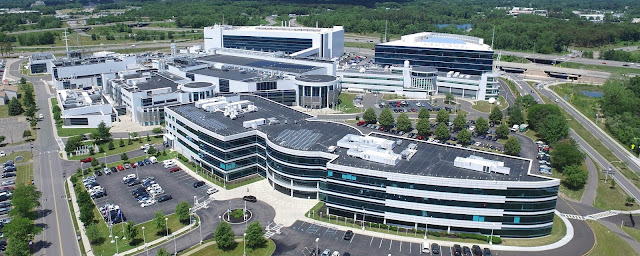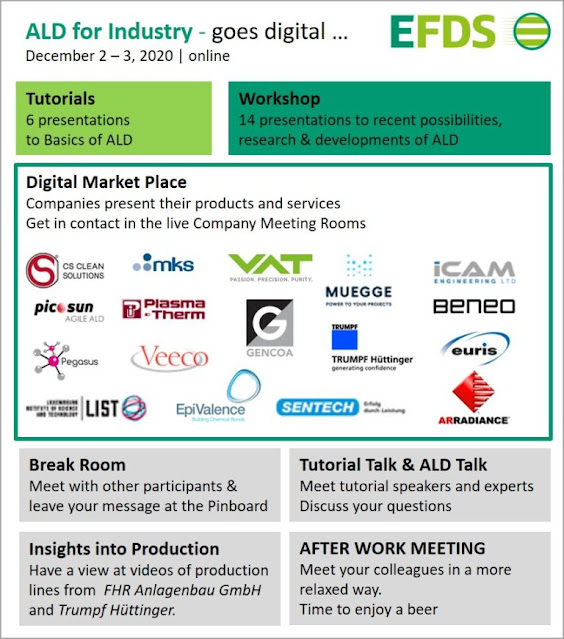Wednesday, December 9, 2020
ALD to take over more and more as CVD and spin-on processes no longer are viable for 3D NAND
- Gapfill dielectrics
- Conformal liners
- Patterning spacers and masks
- Hermetic encapsulation
- Etch stop layers
- Optical films
Monday, December 7, 2020
Chipmetrics Oy commercialises 3D test chip for ALD developed by VTT
High-quality HfS2 2D-material by ALD at 100°C
A high-quality 2D-material by #ALDep at 100°C! Yuanyuan's very systematic and complete study of the well-behaved surface chemistry performed in collaboration with 7 other groups @FAU_Germany is published in Adv. Mater. Interfaces:https://t.co/Y9g1RPsdTx pic.twitter.com/dW8bG0BHAD
— CTFM lab (@CtfmLab) December 6, 2020
Thursday, December 3, 2020
AtomicLimits launch picture database for Atomic Level Processing
PICOSUN® Sprinter launch disrupting fast batch ALD on 300 mm wafers at EFDS ALD for Industry 2020
Picosun launches PicoOS™, a unified control software for PICOSUN® ALD modules and clusters
Wednesday, December 2, 2020
The global semiconductor market is projected to grow by 8.4 percent in 2021 according to WSTS Forecast
Saturday, November 28, 2020
SAMCO launch ALD system for MEMS and SiC and GaN power devices
Ferroelectric Memory GmbH (FMC) Raises $20 M to Accelerate Next-Generation Memory for AI, IoT, Edge Computing, and Data Center Applications
Intel remains in the lead in 2020 semiconductor sales
Applied Materials will regain its No. 1 ranking in the semiconductor equipment market in 2020 from ASML
- Atomic Layer Deposition
- MOCVD
- Furnace
- Dielectric Etch
- Spray Processing
- Dielectric Etch (including ALE)
- Wet Stations
1. Move in to top 3 spot in ALD2. Take number 2 spot in Furnace business
Tuesday, November 24, 2020
Beneq ALD Stories Episode 4 - The story about the BALD Engineering Blog
Thursday, November 19, 2020
Intel to present 3D stacked Nanoribbon Transistors for Continued Moore’s Law Scaling at IEDM 2020
Paper Information (IEDM 2020) : LINK
·
(1) shows
the evolution of transistor architectures from planar, to FinFETs, to
nanoribbons and to a 3D CMOS architecture.
·
(2) (a)
shows a 3D schematic diagram of stacked CMOS Si nanoribbon transistors with
NMOS on PMOS, (b) describes the process flow; (c) is a TEM image of a stacked
multiple-nanoribbon CMOS inverter with a 40-nm gate length and inner (Vss)
and outer (Vcc) contacts, a common gate input (VIN) and
an inverter output node (VOUT); while (d) is a TEM image of two Si
NMOS nanoribbons atop 3 Si PMOS nanoribbons.
·
(3) (a)
is a process flow of the vertically stacked dual S/D EPI process, while (b)
shows P-EPI selectively grown on the bottom three nanoribbons, (c) shows N-EPI
selectively grown on the top two nanoribbons, and (d) features TEM and EDS
images showing selective N-EPI and P-EPI growth on the stacked nanoribbon
transistors.
·
(4)
(a) is a process flow of the vertically stacked dual metal gate process; (b) is
a TEM image and (c, d) are EDS images of the dual metal gate with N-WFM (WFM =
work function metal) on the top two nanoribbons and P-WFM on the bottom three
nanoribbons.
Wednesday, November 18, 2020
Japanese researchers enable high thru put conformal CVD for SiC on Silicon wafer integration
Porous Membranes as Sacrificial Layers Enabling Conformal Chemical Vapor Deposition Involving Multiple Film-Forming Species
Kohei Shima, Yuichi Funato, Noboru Sato, Yasuyuki Fukushima, Takeshi Momose, and Yukihiro Shimogaki
ACS Appl. Mater. Interfaces 2020, 12, 45, 51016–51025
Publication Date:October 30, 2020
https://doi.org/10.1021/acsami.0c14069
Tuesday, November 17, 2020
Roll-To-Roll ALD to Thermally Stabilizing NCM Cathodes for Lithium Ion Batteries
- The capacity retention of TiO2-coated porous electrodes is substantially improved compared to that of the pristine cathode material for high-temperature cycling.
- Electrochemical impedance spectroscopy confirms that the ALD-TiO2 coating suppresses the undesired side reactions initiated at the electrode/electrolyte interface, reduces charge transfer resistance, and ultimately facilitates the Li+ transport through the composite cathode nanostructure.
- The NCM cathode material enables high-temperature operation (>55 °C) with enhanced specific capacity, superior rate capability, excellent cyclability, and high coulombic efficiency within a wide potential window (3.0–4.35 V).
- The R2R ALD technique developed in this work paves the way for large-scale fabrication of ceramic-coated cathode sheets with a production rate reaching 2.4 m min–1 for a continuous coating operation.
New ALD Valve by TLX
AICHE 2020: Machine Learning-Based Modeling and Operation of PEALD of HfO2 Thin-Films
Forge Nano and Argonne improve yield in propylene manufacturing by ALD coating
- deep dehydrogenation
- hydrogenolysis
- cracking
- polymerization
- coke formation.
Zheng Lu, Ryon W. Tracy, M. Leigh Abrams, Natalie L. Nicholls, Paul T. Barger, Tao Li, Peter C. Stair,
Arrelaine A. Dameron, Christopher P. Nicholas, and Christopher L. Marshall
ACS Catal. 2020, 10, XXX, 13957–13967
Publication Date:November 16, 2020
https://doi.org/10.1021/acscatal.0c03391
Monday, November 16, 2020
Dutch SALD and German Fraunhofer to develop Spatial ALD technology for production of 1,000 km range EV battery modules
IBM Research installs EUV tool at SUNY Poly for AI research
Friday, November 13, 2020
ALD for Industry goes digital – an interactive event with lecture program, communication, networking opportunities and after work meeting
4th Workshop, Tutorial – including digital Industrial Exhibition and Company Tour.
Tuesday, November 10, 2020
ALD and Nanotubes on Beneq ALD Stories
Friday, November 6, 2020
Refreshing Material Advances for Logic, Memory, and Packaging5th CMC Conference "After-Hours" Available up to December 11
Thursday, November 5, 2020
Improving Curved uOLED encapsulation with ALD
Wednesday, November 4, 2020
2020 November Networking - ALD at Aalto University, Finland
When : 25.11.–26.11.2020
Where: The event will be held in Zoom
Registration : Registration period: 21.10.2020 12:00 – 11.11.2020 12:00
2020 ALD November Networking Event page
Register here! (Without presentation DL 22.11.)
At Aalto University, many research groups' activities have a connection to atomic layer deposition (ALD). Join our public webinar and local networking event on 25.-26.11.2020. Preliminary program in this link. Registration is free but required.
Aim: Continuing the tradition started in 2019, provide a time and place where especially local people with interest in ALD can meet and get better networked.
Who should come: Researchers (doctoral, postdoctoral, other level) working with a connection to ALD, especially at Aalto University, and also beyond in Finland. Also company representatives welcome. In 2020, invited talks and two tutorials are organized as a Webinar, which is globally open for anyone interested to participate (registration required).
Format: The event will be organized remotely via Zoom. The program is divided in two parts.
Part 1: Public webinar will comprise of (i) high-level international invited talks (Dr. Jonas Sundqvist, Dr. Tuomo Suntola, Dr. Angel Yanguas-Gil) and (ii) tutorials (Prof. Riikka Puurunen, Prof. Matti Putkonen).
Part 2: Local networking will consist of (iii) brief introduction to groups working on ALD in Finland (feel free to contact the responsible organizer to have your Finland-based group added in this introduction), (iv) posters with optional ~2 min pitch talks by doctoral candidates and others working on ALD in Finland; posters in individual Zoom rooms, and (v) other presentations such as brief local company and project introductions.
Lecture capture: Presenters have the possibility to have their talk recorded with Zoom and shared through the Panopto system afterwards (live event; successful recording not guaranteed). After the event, the presenters will be asked for permission to share (no sharing/sharing within Aalto University/sharing openly with the link). No sharing is done without permission.
Organizing committee: Dr. Aitor Arandia Gutierrez, M.Sc. Milad Madadi, Prof. Riikka Puurunen (responsible organizer), Arja Tuohino-Chance, M.Sc. Emma Verkama, M.Sc. Jihong Yim. All from Aalto University, School of Chemical Engineering.
---
Information of the 2019 event, the first event in the series November Networking - ALD at Aalto University: https://blogs.aalto.fi/catprofopen/ald-networking-nov-2019/
JVST A | Special Collection Call for Papers on Atomic Layer Deposition and Atomic Layer Etching
The Journal of Vacuum Science and Technology A is soliciting research articles for publication in Special Topic Collections on Atomic Layer Deposition and Atomic Layer Etching. These special topic collections are planned in collaboration with ALD 2020 and the ALE 2020 Workshop, which were held virtually on June 29—July 1, 2020.
Each year, in concert with the annual Atomic Layer Deposition (ALD) meeting and Atomic Layer Etching (ALE) Workshop, the Journal of Vacuum Science and Technology A publishes collections of articles covering the most recent developments and experimental studies in ALD and ALE. These ALD and ALE Special Topic Collections will include papers presented at ALD 2020 and the ALE 2020 Workshop, as well as other ALD and ALE research articles that were not presented at this conference but are submitted to the special collections. The Collections feature articles dedicated to the science and technology of atomic layer controlled deposition and etching.
Manuscript Deadline: November 18, 2020
Authors are encouraged to use the JVST article template. During submission, you will have an opportunity to tell us that your paper is a part of one of the Collections by choosing either the Special Topic or Conference Collection on “Atomic Layer Deposition (ALD)” or “Atomic Layer Etching (ALE).”
Sunday, November 1, 2020
ASM International CEO Benjamin Loh on Q3 2020 Results
Hamamatsu to release lead-free ALD-MCP Product in Spring 2021
Plasma chemistry data and chemistry set optimisation approach for ALD/ALE modelling
- Problems where simulations can help:
- How to increase radical density using process parameters like pressure, gas flow etc
- How to optimise surface to enhance presence of radicals
- Importance of having a minimal chemistry set but including all important species
- How to start with plasma chemistry design and modelling using www.quantemolDB.com website and free tools



%20(1).png)


























